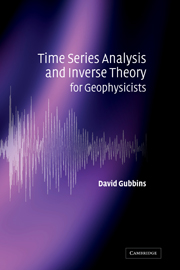Book contents
- Frontmatter
- Contents
- Preface
- Acknowledgements
- List of illustrations
- 1 Introduction
- Part I Processing
- Part II Inversion
- 6 Linear parameter estimation
- 7 The under-determined problem
- 8 Nonlinear inverse problems
- 9 Continuous inverse theory
- Part III Applications
- Appendix 1 Fourier series
- Appendix 2 The Fourier integral transform
- Appendix 3 Shannon's sampling theorem
- Appendix 4 Linear algebra
- Appendix 5 Vector spaces and the function space
- Appendix 6 Lagrange multipliers and penalty parameters
- Appendix 7 Files for the computer exercises
- References
- Index
8 - Nonlinear inverse problems
Published online by Cambridge University Press: 05 June 2012
- Frontmatter
- Contents
- Preface
- Acknowledgements
- List of illustrations
- 1 Introduction
- Part I Processing
- Part II Inversion
- 6 Linear parameter estimation
- 7 The under-determined problem
- 8 Nonlinear inverse problems
- 9 Continuous inverse theory
- Part III Applications
- Appendix 1 Fourier series
- Appendix 2 The Fourier integral transform
- Appendix 3 Shannon's sampling theorem
- Appendix 4 Linear algebra
- Appendix 5 Vector spaces and the function space
- Appendix 6 Lagrange multipliers and penalty parameters
- Appendix 7 Files for the computer exercises
- References
- Index
Summary
Methods available for nonlinear problems
So far we have restricted ourselves to problems where the relationship between the data and the model is linear. The vast majority of forward problems are not linear: these are lumped together and described as ‘nonlinear’, an accurate but not very useful classification because there is no general method for solving nonlinear inverse problems. Available methods are divided here into three broad classes: tricks that work for individual problems; forward modelling, or brute force solution of the forward problem for many candidate model parameters; and linearisation, or approximating the nonlinear forward problem with a linear equation and the use of linear methods.
This is a good time to remind ourselves of the difference between simply finding a model that explains the data, and solving the entire inverse problem. Solving the entire inverse problem involves finding the whole set of models that can explain the data. Finding the model is an exercise in numerical analysis, a vast subject well treated elsewhere, for example in the excellent Numerical Recipes (Press et al., 1992). Solving the inverse problem means finding all possible models that fit the data, a much larger task.
Little can be said in general about special ‘tricks’ that work for just one problem, save to mention that the commonest device is to notice that an apparently nonlinear problem is really a disguised linear problem. A recent example is determination of the geomagnetic field from purely directional data or from intensities alone (Khokhlov et al., 2001).
- Type
- Chapter
- Information
- Time Series Analysis and Inverse Theory for Geophysicists , pp. 125 - 137Publisher: Cambridge University PressPrint publication year: 2004



